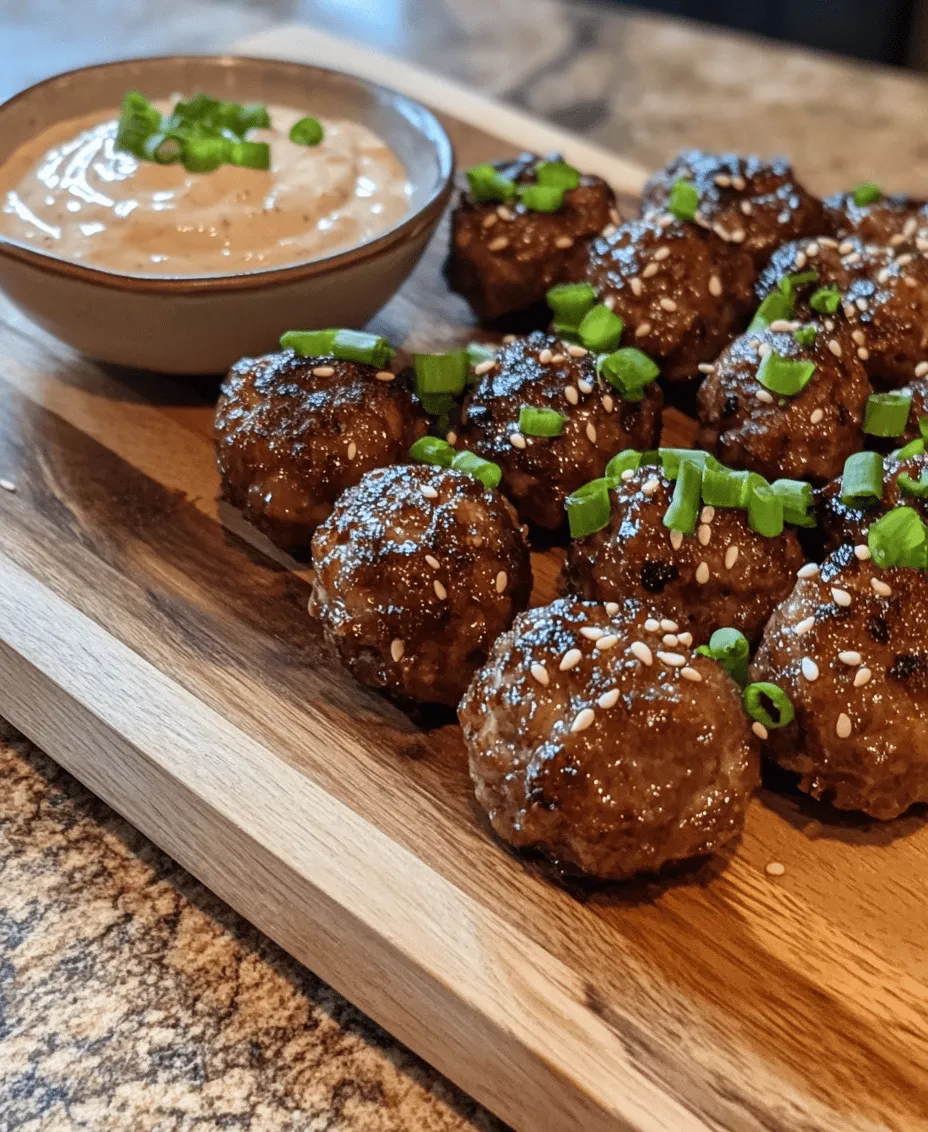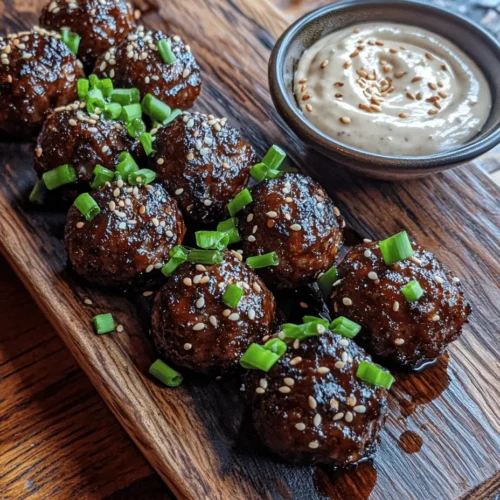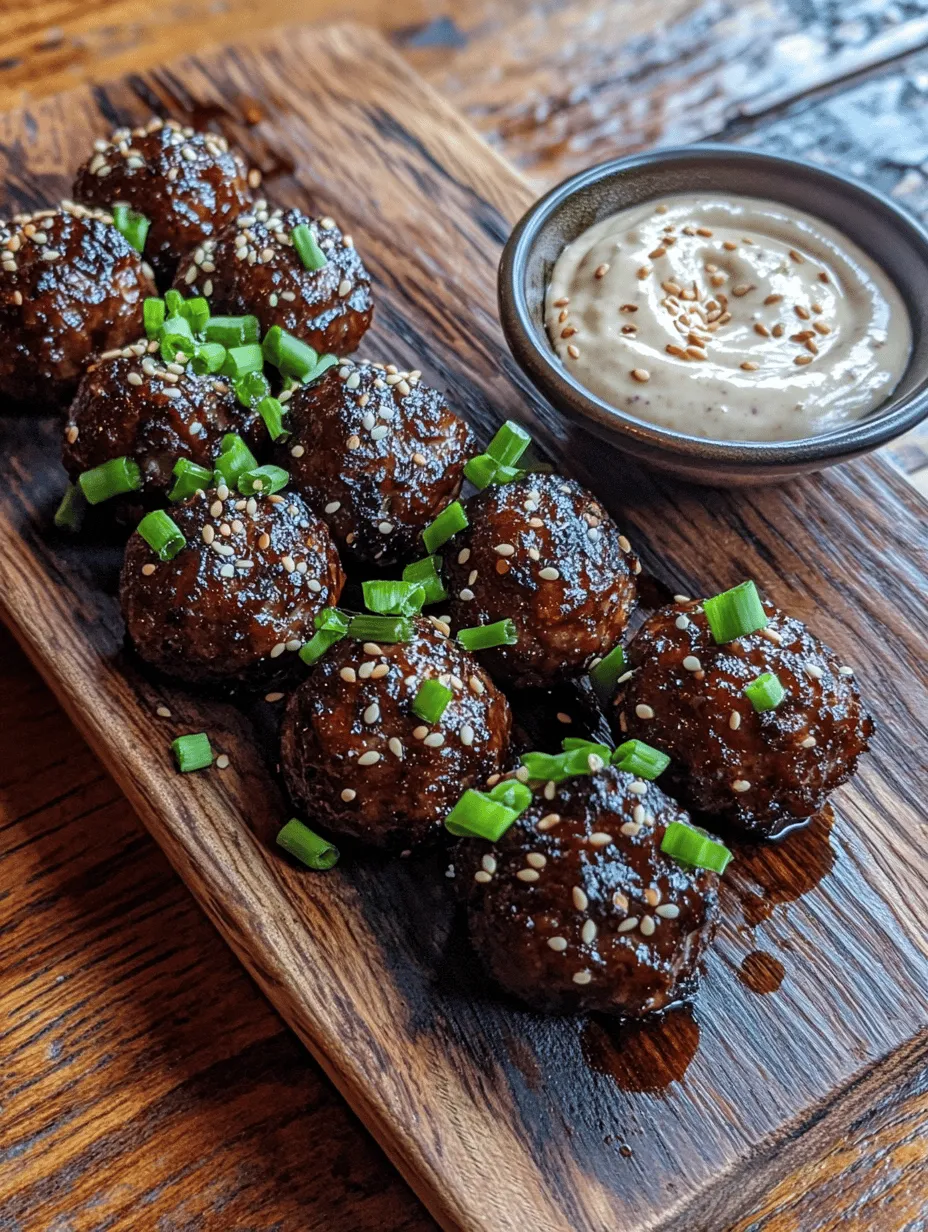Introduction
Korean cuisine has seen a meteoric rise in popularity over the past few years, captivating food lovers with its bold flavors, unique ingredients, and engaging dining experiences. Among the many culinary treasures from Korea, Korean BBQ stands out as an iconic representation of communal dining, where the emphasis is on grilling marinated meats at the table, allowing diners to customize their meal to their liking. The essence of Korean BBQ lies in its harmonious balance of sweet, savory, and spicy flavors, making it a perfect gateway for those eager to explore the rich tapestry of Korean gastronomy.
Today, we will be diving into a delightful twist on traditional Korean BBQ with our recipe for Korean BBQ Meatballs with Spicy Mayo Dip. These meatballs encapsulate the essence of Korean BBQ while providing a convenient and delicious option for gatherings, family dinners, or even a quick weeknight meal. The combination of tender meatballs infused with vibrant flavors, paired with a creamy, spicy dipping sauce, creates an unforgettable culinary experience that is sure to impress.
The beauty of this dish lies in its ability to meld different flavors and textures. The meatballs are not only succulent but also feature the distinct taste profiles that define Korean BBQ, while the spicy mayo dip adds a layer of creaminess and heat that perfectly complements the meat. In this article, we will explore the origins of Korean BBQ, dissect the key ingredients, and guide you through the initial steps to prepare these delicious meatballs that will have everyone asking for seconds.
Understanding Korean BBQ Influences
Korean BBQ, or “gogi-gui,” traces its roots back to ancient times when meat was grilled over an open flame to preserve its flavor and tenderness. Over the centuries, this method evolved, leading to the diverse array of dishes we enjoy today. The communal aspect of Korean BBQ dining fosters a sense of togetherness, as friends and family gather around the grill, sharing not only food but also stories and laughter. This interactive experience enhances the enjoyment of the meal and highlights the importance of food in Korean culture.
At the heart of Korean BBQ are the bold flavor profiles that characterize the cuisine. The primary tastes include sweetness, spiciness, and umami, often achieved through the use of ingredients like soy sauce, sesame oil, and various types of chili paste. These flavor elements combine to create a dish that is both satisfying and exciting. The versatility of Korean BBQ also allows for various interpretations, such as incorporating meatballs, which provide a fun and approachable way to experience these rich flavors.
Meatballs, while not a traditional staple of Korean BBQ, have become a popular vessel for showcasing the vibrant flavors of the cuisine. Their bite-sized nature makes them perfect for sharing, and they can easily absorb the marinades and seasonings that define the genre. Whether served as an appetizer or a main course, Korean BBQ meatballs offer a delightful and convenient option for those looking to enjoy the essence of Korean flavors without the need for extensive preparation or grilling.
Ingredients Breakdown
To create our Korean BBQ Meatballs with Spicy Mayo Dip, we will need a selection of high-quality ingredients that will enhance the dish’s flavor and texture. Here’s a detailed breakdown of the essential components:
Main Ingredients for the Meatballs
1. Ground Beef vs. Ground Pork: The choice of meat is crucial when making meatballs. Ground beef offers a robust flavor and rich texture, while ground pork provides a slightly sweeter and more tender bite. Both options are nutritious, with ground pork generally containing more fat, which can contribute to juiciness in the finished product. Depending on your preference, feel free to use one or the other, or even a blend of both for added complexity.
2. Panko Breadcrumbs: When it comes to binding the meatballs, panko breadcrumbs are preferred over regular breadcrumbs due to their light and airy texture. Panko allows for a crispier exterior and a tender interior, ensuring that the meatballs do not become dense or dry during cooking.
3. Aromatics: The foundation of flavor in these meatballs comes from aromatics such as green onions, garlic, and ginger. Green onions impart a mild, fresh flavor while garlic adds depth, and ginger introduces a zesty kick. Together, they create a fragrant base that enhances the overall taste of the meatballs.
Flavor Enhancers
4. Soy Sauce: This essential ingredient provides the umami depth that is characteristic of Korean BBQ. Soy sauce adds saltiness and richness, helping to elevate the flavors of the meat.
5. Sesame Oil: A small amount of sesame oil not only enhances the overall flavor profile but also introduces a nutty aroma that is quintessential in Korean cooking. It’s important to use roasted sesame oil for the best flavor.
6. Brown Sugar: A touch of brown sugar is added to balance the savory and spicy notes. The sweetness complements the other flavors and helps to create a caramelized exterior when the meatballs are cooked.
7. Gochugaru: This coarsely ground Korean chili pepper adds a mild heat and a beautiful red color to the meatballs. Gochugaru is essential for achieving the authentic spicy flavor associated with Korean cuisine. Adjust the quantity according to your heat tolerance; it can be omitted for a milder version.
Ingredients for the Spicy Mayo Dip
The Spicy Mayo Dip is a crucial accompaniment that ties the dish together, providing a creamy contrast to the savory meatballs. Here’s what you’ll need:
1. Mayonnaise: The base of the dip, mayonnaise brings creaminess and a velvety texture. It acts as a perfect canvas for the other flavors.
2. Gochujang: This fermented chili paste is a staple in Korean cooking, known for its complex flavor profile that combines sweetness, spice, and umami. When mixed with mayonnaise, it transforms the dip into a zesty and flavorful accompaniment.
3. Rice Vinegar: A splash of rice vinegar adds acidity to the dip, balancing out the richness of the mayonnaise and enhancing the overall flavor profile.
4. Lemon Juice: Fresh lemon juice provides brightness and a hint of citrus that cuts through the richness, elevating the dip to new heights.
With these ingredients at hand, you’re well on your way to crafting mouthwatering Korean BBQ meatballs that will delight your taste buds and impress any gathering. In the next section, we will outline the step-by-step process to prepare these delectable meatballs and the accompanying spicy mayo dip, ensuring that you can recreate this dish with confidence and ease.

Customizing the Dip: Adjusting Sweetness and Spice
One of the best aspects of the spicy mayo dip accompanying Korean BBQ meatballs is its versatility. You can easily customize it to suit your palate. If you prefer a sweeter dip, consider adding a bit more honey or sugar until it reaches your desired level of sweetness. Conversely, if you like it spicier, increase the amount of gochujang or add a dash of hot sauce. Taste-testing is key here—start with small increments and adjust as needed. Balancing the flavors will enhance the overall experience of your Korean BBQ meatballs.
Step-by-Step Preparation Process
Preparing the Meatballs: Essential Tips for Mixing and Not Overworking the Meat
To achieve the perfect meatball texture, begin by combining your ground meat with the other ingredients in a large mixing bowl. Whether you are using beef, pork, or a blend, it’s essential to mix gently. Overworking the meat can lead to tough meatballs, which is not what you want. Use your hands to combine the ingredients just until they are evenly mixed, and then stop. This method ensures a tender bite once cooked.
Shaping the Meatballs: Importance of Uniform Size for Even Cooking
Once your mixture is ready, it’s time to shape the meatballs. Aim for uniformity in size—about 1 to 1.5 inches in diameter works well. Using a small ice cream scoop or your hands, form each meatball gently. Consistent sizes not only help in achieving even cooking but also improve the presentation when served. If you have a baking tray, line it with parchment paper to prevent sticking and make cleanup easier.
Baking the Meatballs: Optimal Temperature and Baking Time for Perfect Texture
Preheat your oven to 400°F (200°C). This temperature is ideal for baking meatballs as it allows them to cook through while developing a nice outer crust. Place the shaped meatballs on the lined baking sheet, ensuring they are spaced apart to allow air circulation. Bake for 20-25 minutes, or until they are golden brown and reach an internal temperature of 165°F (74°C). If you want a little extra flavor, you can brush them with soy sauce halfway through baking for a savory finish.
Optional Flavor Enhancement Techniques
For those looking to elevate the flavor profile even further, consider a quick glaze during the last few minutes of baking. Combine soy sauce, sesame oil, and a sprinkle of sugar in a small bowl, then brush this mixture over the meatballs. This will not only enhance the umami flavor but also give them a glossy finish that makes them visually appealing.
Making the Spicy Mayo Dip: Whisking Methods for Achieving the Right Consistency
To prepare the spicy mayo dip, start with a base of mayonnaise. Add gochujang, lime juice, and honey in a mixing bowl. Using a whisk, combine these ingredients until smooth. Adjust the consistency according to your preference—if you’d like it thinner, you can add a bit of water or more lime juice. Make sure to taste it as you go to find the perfect balance of creaminess, spiciness, and tanginess.
Serving Suggestions: Ideal Garnishes and Presentation Tips
When it comes to serving your Korean BBQ meatballs, presentation is key. Arrange the meatballs on a platter and provide the spicy mayo dip in a small bowl nearby. Garnish the meatballs with finely chopped green onions or sesame seeds for a pop of color and added flavor. You might also consider serving them on a bed of lettuce leaves, which not only adds a fresh crunch but also helps with portion control if served as an appetizer.
For a full meal experience, pair these meatballs with a side of steamed rice or a simple Asian slaw. This adds balance to the dish and allows guests to enjoy the flavors in different ways.
Nutritional Insights
Analysis of the Nutritional Profile of the Meatballs and Dip
Korean BBQ meatballs are not only delicious but also provide a satisfying nutritional profile. Each meatball offers a good source of protein, especially if made with lean ground meats. The spicy mayo dip, while creamy, can be adjusted to be lighter or richer depending on the ingredients used.
Protein Content from Ground Meat
Using ground beef or pork, each serving of meatballs offers a substantial amount of protein, which is essential for muscle repair and overall body function. For those looking to reduce fat intake, lean ground turkey or chicken can be excellent substitutes without compromising the flavor.
Benefits of Using Fresh Ingredients like Green Onions and Ginger
Incorporating fresh ingredients such as green onions and ginger not only enhances flavor but also adds health benefits. Green onions are known for their antioxidant properties, while ginger can aid in digestion and reduce inflammation.
Discussion on Serving Sizes and Potential Modifications for Dietary Preferences
When serving these Korean BBQ meatballs, consider the portion sizes. A serving of three to four meatballs is typically satisfying, especially when paired with sides. For those with dietary restrictions, there are modifications to consider. Making the meatballs gluten-free is easily accomplished by using gluten-free breadcrumbs or omitting them altogether for a low-carb option. Vegetarian versions can be created using plant-based meat alternatives or even chickpeas for a hearty texture.
Cultural Significance of Korean BBQ
The Communal Aspect of Korean BBQ Dining
Korean BBQ is more than just a meal; it’s an experience that emphasizes community and togetherness. Traditionally, the cooking takes place at the table, allowing diners to grill their own meats and share dishes. This communal aspect fosters conversation and connection, making meals a cherished occasion.
How This Recipe Fits into Modern Korean Cuisine and Its Fusion with Western Tastes
Korean cuisine has evolved, integrating influences from various cultures. This recipe for Korean BBQ meatballs illustrates how traditional flavors can be adapted to suit modern palates, merging with Western favorites like meatballs. The incorporation of gochujang, soy sauce, and fresh ingredients makes this dish approachable while staying true to its roots.
The Growing Popularity of Korean Flavors in Home Cooking
Korean flavors have gained immense popularity in recent years, with more home cooks eager to explore this vibrant cuisine. The accessibility of ingredients like gochujang and sesame oil in supermarkets has made it easier than ever to bring these flavors into the home kitchen. Recipes like Korean BBQ meatballs allow anyone to experience the joy of Korean cooking without the need for extensive culinary knowledge.
Conclusion
Making Korean BBQ meatballs with spicy mayo dip is a delightful culinary journey that invites you to explore the dynamic flavors of Korean cuisine. By taking the time to prepare each component—balancing spices, textures, and presentation—you not only create a delicious dish but also an experience to share with family and friends.
Whether you are hosting a gathering or simply looking to enjoy a flavorful meal at home, this recipe serves as a gateway to the rich world of Korean flavors. Embrace the opportunity to experiment with spice levels, dipping sauces, and side dishes, and enjoy the satisfaction of sharing these delightful flavors with loved ones. As you dive into this culinary adventure, remember that the joy of cooking and sharing food is what truly makes a meal memorable.



